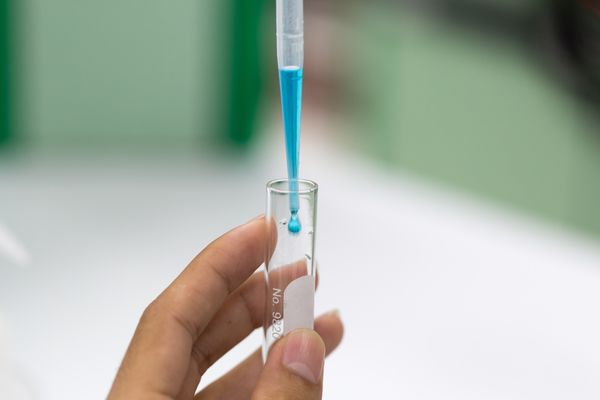4.2.3
Osmosis
Osmosis
Osmosis
Osmosis is the diffusion of water across a partially permeable membrane from a dilute solution (high concentration of water) to a concentrated solution (low concentration of water).


Partially permeable membrane
Partially permeable membrane
- A partially permeable membrane allows water through, but won't let larger molecules dissolved in water pass through.
-min,h_400,q_80,w_640.png)
-min,h_400,q_80,w_640.png)
Water movement
Water movement
- Water will move to make the concentrations the same on both sides of the membrane. The likelihood of water molecules diffusing is called the water potential.
- When there are lots of water molecules (in a dilute solution) on one side of a partially permeable membrane, but not many on the other side (in a concentrated solution), water will move from the dilute to the concentrated solution.


Net movement of water
Net movement of water
- It is important to remember that water molecules will move through the membrane in both directions, but the net (overall) movement of water will be from the dilute solution to the concentrated solution.


Water potential
Water potential
- Pure water has the greatest water potential and concentrated solutions have lower water potentials.
- Isotonic solutions are said to have equal water potentials on either side of the membrane.
-min,h_400,q_80,w_640.png)
-min,h_400,q_80,w_640.png)
Rate of osmosis
Rate of osmosis
- The lower the water potential gradient, the slower the rate of osmosis.
- The thicker the membrane, the slower the rate of osmosis.
- The smaller the surface area, the slower the rate of osmosis.
Identifying Water Potential of Plant Cells
Identifying Water Potential of Plant Cells
To identify the water potential of a plant tissue, a calibration curve must be made for allowing a comparison of the unknown tissue. This involves monitoring any mass changes to plant tissue that is placed into known concentrations of sucrose.


1) Cut the potato pieces
1) Cut the potato pieces
- Carefully cut pieces of peeled potato into chips that are around 2cm long.
- The chips must all be the same shape, size (uniform) and mass (to at least 2 decimal places).


2) Place chips in boiling tubes
2) Place chips in boiling tubes
- Put each chip in separate boiling tubes.
- Each boiling tube should contain different sucrose concentrations (e.g. 0.1, 0.2, 0.3, 0.4, 0.5 dm−3).
- Use distilled water (0.0 dm−3) as the control group.
- Make sure the whole chip is submerged in the solution and heat in a water bath at 30°C for 20 minutes.


3) Reweigh the chips
3) Reweigh the chips
- Blot the chips until they are dry.
- Weigh and measure the chips again.
,h_400,q_80,w_640.png)
,h_400,q_80,w_640.png)
4) Plot the graph
4) Plot the graph
- Plot a graph with sucrose concentration along the x-axis and mass change along the y-axis.
- There should be both negative and positive values on the y-axis.
- Plot the values and draw a line of best fit.
,h_400,q_80,w_640.png)
,h_400,q_80,w_640.png)
5) Interpret the graph
5) Interpret the graph
- The concentration where the line crosses the x-axis represents the water potential of the potato.
- This is the isotonic point.
- The isotonic point is where water has not moved into or out of the tissue because the water potential is the same inside the cells as the solution is outside.
1Cell Structure
1.1Cell Structure
1.1.1Studying Cells - Microscopes
1.1.2Introduction to Eukaryotic & Prokaryotic Cells
1.1.3Ultrastructure of Eukaryotic Cells
1.1.4Ultrastructure of Eukaryotic Cells 2
1.1.5Ultrastructure of Eukaryotic Cells 3
1.1.6Prokaryotic Cells
1.1.7Viruses
1.1.8End of Topic Test - Cell Structure
1.1.9Exam-Style Question - Microscopes
1.1.10A-A* (AO2/3) - Cell Structure
2Biological Molecules
2.1Testing for Biological Modules
2.2Carbohydrates & Lipids
2.3Proteins
3Enzymes
4Cell Membranes & Transport
4.1Biological Membranes
5The Mitotic Cell Cycle
6Nucleic Acids & Protein Synthesis
6.1Nucleic Acids
7Transport in Plants
8Transport in Mammals
8.1Circulatory System
8.2Transport of Oxygen & Carbon Dioxide
9Gas Exchange
9.1Gas Exchange System
10Infectious Diseases
10.1Infectious Diseases
10.2Antibiotics
11Immunity
12Energy & Respiration (A2 Only)
13Photosynthesis (A2 Only)
14Homeostasis (A2 Only)
14.1Homeostasis
14.2The Kidney
14.3Cell Signalling
14.4Blood Glucose Concentration
14.5Homeostasis in Plants
15Control & Coordination (A2 Only)
15.1Control & Coordination in Mammals
15.1.1Neurones
15.1.2Receptors
15.1.3Taste
15.1.4Reflexes
15.1.5Action Potentials
15.1.6Saltatory Conduction
15.1.7Synapses
15.1.8Cholinergic Synnapses
15.1.9Neuromuscular Junction
15.1.10Skeletal Muscle
15.1.11Sliding Filament Theory Contraction
15.1.12Sliding Filament Theory Contraction 2
15.1.13Menstruation
15.1.14Contraceptive Pill
15.2Control & Co-Ordination in Plants
16Inherited Change (A2 Only)
16.1Passage of Information to Offspring
16.2Genes & Phenotype
17Selection & Evolution (A2 Only)
17.2Natural & Artificial Selection
18Classification & Conservation (A2 Only)
18.1Biodiversity
18.2Classification
19Genetic Technology (A2 Only)
19.1Manipulating Genomes
19.2Genetic Technology Applied to Medicine
19.3Genetically Modified Organisms in Agriculture
Jump to other topics
1Cell Structure
1.1Cell Structure
1.1.1Studying Cells - Microscopes
1.1.2Introduction to Eukaryotic & Prokaryotic Cells
1.1.3Ultrastructure of Eukaryotic Cells
1.1.4Ultrastructure of Eukaryotic Cells 2
1.1.5Ultrastructure of Eukaryotic Cells 3
1.1.6Prokaryotic Cells
1.1.7Viruses
1.1.8End of Topic Test - Cell Structure
1.1.9Exam-Style Question - Microscopes
1.1.10A-A* (AO2/3) - Cell Structure
2Biological Molecules
2.1Testing for Biological Modules
2.2Carbohydrates & Lipids
2.3Proteins
3Enzymes
4Cell Membranes & Transport
4.1Biological Membranes
5The Mitotic Cell Cycle
6Nucleic Acids & Protein Synthesis
6.1Nucleic Acids
7Transport in Plants
8Transport in Mammals
8.1Circulatory System
8.2Transport of Oxygen & Carbon Dioxide
9Gas Exchange
9.1Gas Exchange System
10Infectious Diseases
10.1Infectious Diseases
10.2Antibiotics
11Immunity
12Energy & Respiration (A2 Only)
13Photosynthesis (A2 Only)
14Homeostasis (A2 Only)
14.1Homeostasis
14.2The Kidney
14.3Cell Signalling
14.4Blood Glucose Concentration
14.5Homeostasis in Plants
15Control & Coordination (A2 Only)
15.1Control & Coordination in Mammals
15.1.1Neurones
15.1.2Receptors
15.1.3Taste
15.1.4Reflexes
15.1.5Action Potentials
15.1.6Saltatory Conduction
15.1.7Synapses
15.1.8Cholinergic Synnapses
15.1.9Neuromuscular Junction
15.1.10Skeletal Muscle
15.1.11Sliding Filament Theory Contraction
15.1.12Sliding Filament Theory Contraction 2
15.1.13Menstruation
15.1.14Contraceptive Pill
15.2Control & Co-Ordination in Plants
16Inherited Change (A2 Only)
16.1Passage of Information to Offspring
16.2Genes & Phenotype
17Selection & Evolution (A2 Only)
17.2Natural & Artificial Selection
18Classification & Conservation (A2 Only)
18.1Biodiversity
18.2Classification
19Genetic Technology (A2 Only)
19.1Manipulating Genomes
19.2Genetic Technology Applied to Medicine
19.3Genetically Modified Organisms in Agriculture
Unlock your full potential with Seneca Premium
Unlimited access to 10,000+ open-ended exam questions
Mini-mock exams based on your study history
Unlock 800+ premium courses & e-books